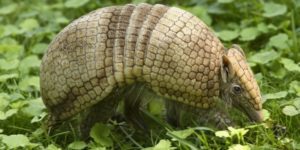In what may look like a perfectly calm garden bed, the soil is literally crawling with life. Yes, it’s true. Surprising, isn’t it? Sort of like the shock of finding out that there are creatures living in your eyelashes. You didn’t know? Yep, they’re called Demodex.
A healthy rhizosphere contains about a billion bacteria, several yards of fungal filaments, several thousand protozoa, and scores of nematodes in a single teaspoon, according to Kathy Merrifield, a retired nematologist at Oregon State University. Actually, rhizosphere is a very useful word. It means the soil surrounding plant roots. And each organism and microorganism seems to be symbiotic. They all need each other.
I remember my 7th grade science teacher (amazing that I can remember that far back) tried to teach us that every living thing has a purpose; if only to be food for something else. She taught us a little rhyme:
Big fleas have little fleas,
Upon their backs to bite ‘em.
And little fleas have lesser fleas,
And so on ad infinitum!
I’ve never forgotten it, so I’m careful when I try to do in some garden creature or other with chemicals. You don’t want to kill off an entire population of anything.
Did I just say that? I surely would like to kill off my population of Chamberbitter, Florida Betony, Virginia creeper, wild bramble and about twenty other noxious weeds. Hand weeding does get rid of aggressive tendencies, but I’m mild by nature so my aggressive tendencies don’t have a chance against the weed population. When the meek inherit the earth, I hope that my share doesn’t have weeds.
We all seem to delight when we see earthworms in our soil, and there are two that you might be familiar with. One is a European species known as the night crawler, that staple of fishing tackle boxes that can measure up to 8 inches long. The other is an Asian worm called the Alabama jumper (AKA jumping worm, snake worm, or crazy worm) that you can spot by the wild thrashing that helps it literally jump off the ground. These are good for our garden soil, but so many worms are not native and those like to chomp on leaves and forest detritus, so they have begun to decimate the forest floors which helps nourish the soil and shelter insects and grubs which feed songbirds and wildlife. Seems like everything has a flip side.
I certainly don’t advocate baking Mrs. McGregor’s Rabbit Pie, but Peter Rabbit and his family have certainly invaded and wrecked my dahlias and lilies. Lilies are my favorite plants, and I had planted dozens more last year. Imagine my shock when I went outside one morning and found only 4 or 5 inch stalks! My yard is fenced against deer and, I thought, against any invading critters. Rabbits and Opossums are not deterred by fences. They simply burrow under them. I found out this year that rabbits also love dahlias. I had put my lilies in pots to be safe, but the dahlias met the same fate as my lilies. I potted up the few survivors I found, but between lilies and dahlias, I’m running out of pots!
You all know how I feel about moles, but for some reason my dogs have stopped digging for them. They never got any, anyway, and now I can walk in my garden without fear of spraining an ankle in the holes they’ve dug. Since moles spend their lives underground, they have few natural predators to keep their populations at bay. Oh well, laissez faire.
Armadillos are slowing making their way north, and the Lowcountry is in their traffic pattern. Their natural predators are bears, coyotes, foxes and even raccoons. The Lowcountry is short on most of those, and Armadillos can really wreak havoc in your garden. They actually top the list of nuisance wildlife in South Carolina.
If you have a problem with those critters, it’s best to call in professionals. Armadillos harbor bacteria and parasites dangerous to humans. Never touch them with bare hands, or get any fluid or blood from them on your hands.
It’s hard not to find the antics of squirrels and raccoons amusing. That is, until they turn over your trash and potted plants and steal your bird feeders. Both are very clever at outwitting your best efforts to deter them. My latest fix for the raccoons and opossums that invade the pots on my porch is motion activated spotlights. It’s disconcerting to have them go on and off whilst sitting in my family room, but at least they’re doing their job without violence or bloodshed!
Have no doubt there are snakes in your garden, but it’s unlikely you’ll be bitten by one. However, don’t tempt fate and don’t reach into places you can’t see. Use common sense and poke your rake into shrubs before you weed around them.
The buzz acronym for these critters is IPM – Integrated Pest Management. “Integrated Pest Management is a sustainable, science-based, decision-making process that combines biological, cultural, physical and chemical tools to identify, manage and reduce risk from pests and pest management tools and strategies in a way that minimizes overall economic, health and environmental risks.”
Whew! In a nutshell, it means moderation. Learn to live with an acceptable population of pests in your landscape. It’s the responsible thing to do because it’s essential to the food chain.
It’s comforting, though, to know that we humans are at the top of the food chain.
So far.
Gardening Tip: Deadheading spent flowers encourages more blooms. Don’t wait until they’re totally dead and unsightly.








